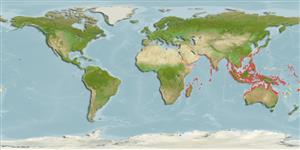Common names from other countries
Classification / Names / Names
आम नाम | उपशब्द | Catalog of Fishes (gen., sp.) | ITIS | CoL | WoRMS
Environment: milieu / climate zone / depth range / distribution range
पारिस्थितिकी
. Tropical
Indo-West Pacific.
Length at first maturity / आकार / वज़न / Age
Maturity: Lm ? range ? - ? cm Max length : 4.0 cm SHL पुल्लिंग / अलिंग; (Ref. 348); common length : 2.0 cm SHL पुल्लिंग / अलिंग; (Ref. 348); अधिकतम सूचित उम्र: 3.00 वर्षो (Ref. 8702)
Found in intertidal areas in sand; typical inhabitants of exposed beaches in the tropics and subtropics usually with other Donax species; are tidal migrants (Ref. 084495), are thus affected by changes in the beach profile due to erosion and accretion cycles brought about by the tides and by the monsoon seasons.
Life cycle and mating behavior
परिपक्व अवधि | पुनरुत्पत्ति | मछलीऔ का अंडे देना | अंडे | Fecundity | लार्वा
Members of the class Bivalvia are mostly gonochoric, some are protandric hermaphrodites. Life cycle: Embryos develop into free-swimming trocophore larvae, succeeded by the bivalve veliger, resembling a miniature clam.
Poutiers, J.M. 1998. (Ref. 348)
IUCN Red List Status (Ref. 130435)
CITES status (Ref. 108899)
Not Evaluated
Not Evaluated
Threat to humans
Harmless
Human uses
| FishSource |
साधन
अधिक जानकारी
Age/Sizeबाढ़Length-weightLength-lengthआकृति विज्ञानलार्वाबहुतायत
इंटरनेट स्रोत
Estimates based on models
लौटाव
ऊंचा, न्यूनतम जनसंख्या दुगनी समय अवलागत 15 महीने। (K=0.16-1.7; tmax=3).
Vulnerability
Low vulnerability (10 of 100).
